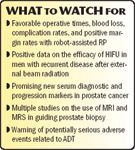Article
Strides in minimally invasive surgery changing prostate cancer treatment
Highlights of the prostate cancer research presented at the 2007 AUA meeting will include maturing data on minimally invasive surgery, information on novel markers, and reports on diagnostic imaging techniques.

Key Points
Attendees at the AUA annual meeting can expect to hear about numerous developments in the diagnosis and management of prostate cancer. Highlights will include maturing data on minimally invasive surgery, information on novel markers, and reports on diagnostic imaging techniques. Clinicians should also pay attention to studies reporting on serious risks of androgen deprivation therapy (ADT) and antimicrobial resistance of pathogens causing post-biopsy infection, said Richard D. Williams, MD, Rubin H. Flocks Chair, department of urology, University of Iowa, Iowa City.

Of particular interest in the area of minimally invasive surgery will be positive data on the efficacy of high-intensity focused ultrasound for treating men who have recurrent disease after external beam radiation therapy. In addition, two groups will report on large series of patients undergoing robot-assisted radical prostatectomy that show favorable operative times, blood loss, complication rates, and positive margin rates.
Diagnostic advancements

Other groups will present results from measurements of serum sex hormone binding globulin in radical prostatectomy patients that show it was very useful for identifying men who had extracapsular extension or positive lymph nodes. Researchers studying serum levels of F2 and F3, electrophoretic subforms of free PSA, will report the finding that an increased F2:F3 ratio enhances the diagnostic accuracy of PSA for identifying prostate cancer.
Another novel assay that has shown early promise for differentiating between men with and without prostate cancer measures intracellular PSA in peripheral blood macrophages. Data will also be presented on detection of the TMPRSS2:ERG gene fusion in prostate cancer cells and urine that suggest it may be useful for diagnosis, risk assessment, and recurrence detection.
"I think the identification of a diagnostic marker more specific for prostate cancer and/or a progression marker is definitely on the horizon. Those tools will be important for helping us to identify patients who are likely to progress and, thus, require immediate treatment versus those at lower risk who can be managed expectantly," Dr. Williams said.
Regarding expectant management, interesting data will be reported on prostate cancer patients undergoing active surveillance with periodic biopsies that showed no difference in their progression-free survival compared to that of men followed without repeat biopsy.
"More study is needed, but this information indicates low-risk men can be followed carefully without routinely being re-biopsied," Dr. Williams said.
Nerve grafting update
Results of two prospective studies also dampen initial enthusiasm for the use of autologous sural nerve grafting for sexual rehabilitation after radical prostatectomy. Those investigators are reporting no difference in potency rates among men who underwent unilateral or bilateral nerve-sparing radical prostatectomy with a nerve graft compared with no-graft controls.





